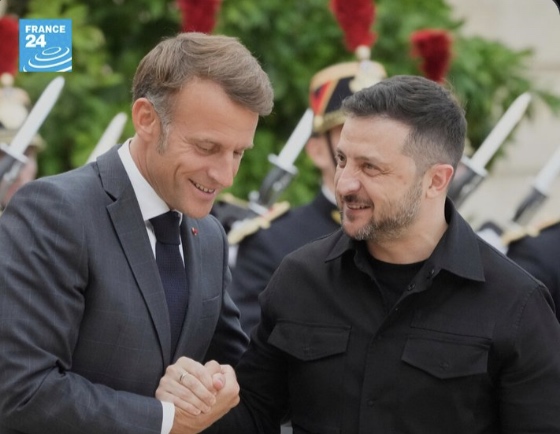


The deal — reportedly to be announced in talks with French President Emmanuel Macron — is expected to include not only additional Mirage jets and Aster-30 surface-to-air missiles, but potentially far more ambitious equipment: Dassault Rafale multi-role combat aircraft, advanced air-defence systems, and anti-drone weaponry.
Zelenskyy has long spoken of the need for Ukraine to modernise its ageing Soviet-era air force, particularly as Russian drone and missile strikes intensify. In a post on X ahead of his trip, he wrote that the agreement would significantly strengthen the country’s combat aviation, air defence, and other defence capabilities.
But while optimism in Kyiv is high, there is no shortage of practical challenges. Some of the proposed jets — in particular the Rafale — would come via a long-term, ten-year strategic aviation agreement, according to sources cited by Reuters. Part of the aircraft could be drawn from existing French stocks, but a substantial portion would form part of a broader build-up: Ukraine reportedly aims to construct a fleet of roughly 250 warplanes, including U.S. F-16s and Swedish Gripens.
Any such modernization, though, hinges on pilot training. The Rafale, a sophisticated twin-engine jet, would demand rigorous training for Ukrainian aircrews — a process not likely to be completed overnight.
In addition to jets, the deal is expected to include further SAMP/T air-defence systems, either from existing French stockpiles or via long-term procurement. These systems use the Aster-30 missile, made by MBDA, which Ukraine already operates, offering a layered shield against high-altitude threats.
There is also talk of anti-drone systems and next-generation missile orders — reflecting how Ukraine views its air-defence as not just a means of countering conventional aircraft, but as an essential bulwark against Russia’s increasingly complex aerial playbook.
That Paris is even able to move forward with such a sizable commitment to Kyiv is politically delicate. While Macron has pledged support, France faces its own domestic constraints — not least budgetary and political instability. Critics argue that pledging heavy military hardware is one thing; financing it, and sustaining it, is another.
Still, Macron’s office has framed the deal in bold, declarative terms: France’s arms industry — epitomised by Dassault and MBDA — will be placed “at the service of Ukraine’s defence.” The contract-signing is expected to include a letter of intent, with further firm contracts to follow.
Beyond raw weapons, Zelenskiy’s Paris agenda is dense with strategic cooperation. In the morning, he is due to attend a briefing with French aerospace corporations, including Dassault, before signing formal documents later in the day. In the afternoon, Ukrainian and French firms working in drone technology will convene to explore partnerships.Given how crucial drones have become in the war, from reconnaissance to attack roles, that sector could prove nearly as consequential as the jet deal itself.
For Kyiv, this is about more than just surviving the present — it’s about building an air force capable of enduring in the long term. The potential inclusion of Rafale jets alongside F-16s and Gripens reflects a carefully considered, three-platform strategy. Analysts note that such a fleet would dramatically boost Ukraine’s NATO interoperability and deter future attacks.
That said, transferring and operating high-performance aircraft is no simple feat. Even once deals are signed, Ukraine must train pilots, integrate logistics chains, and maintain the fleet — all while under the shadow of ongoing conflict.
Despite the fanfare, the visit raises some serious questions. Two of the key issues remain financing and delivery timelines. Sources say that how the deals will be paid for is still unclear. Will France offer favourable credit? Will other European partners contribute? Or will Kyiv have to rely on frozen Russian assets or future budget windfalls?
Moreover, even if Rafale jets are promised, they may only be delivered gradually — especially if they are drawn from production rather than reserves. That delays their immediate impact.
On the political front, any major arms deal further ties France to Ukraine’s war effort, a commitment that could come under strain if domestic priorities shift or European fatigue sets in. And yet, the symbolic impact of such a “historic” agreement cannot be understated. For Zelenskyy, securing France’s backing in Paris sends a powerful signal: Ukraine is not alone.
Zelenskyy’s Paris trip may well mark a watershed moment. If concluded as envisaged, the agreement could significantly enhance Ukraine’s air-defence architecture, giving Kyiv a genuine shot at building a Western-standard air force. It also deepens industrial and strategic ties between Kyiv and Paris — a relationship that may prove critical not only in winning this war, but in preparing for the next.
Still, agreements on paper are one thing; execution is another. The real test will lie in translating promises into planes, missiles, trained pilots, and operational readiness — all under the twin pressures of war and geopolitics.
As the signing goes ahead later today, the world will be watching. For Ukraine, this could be not just a defensive milestone — but a foundational step toward a sovereign air capability that endures long after the latest barrage has subsided.
France Accuses China of Targeted Disinformation Campaign Against Rafale Fighter Jet